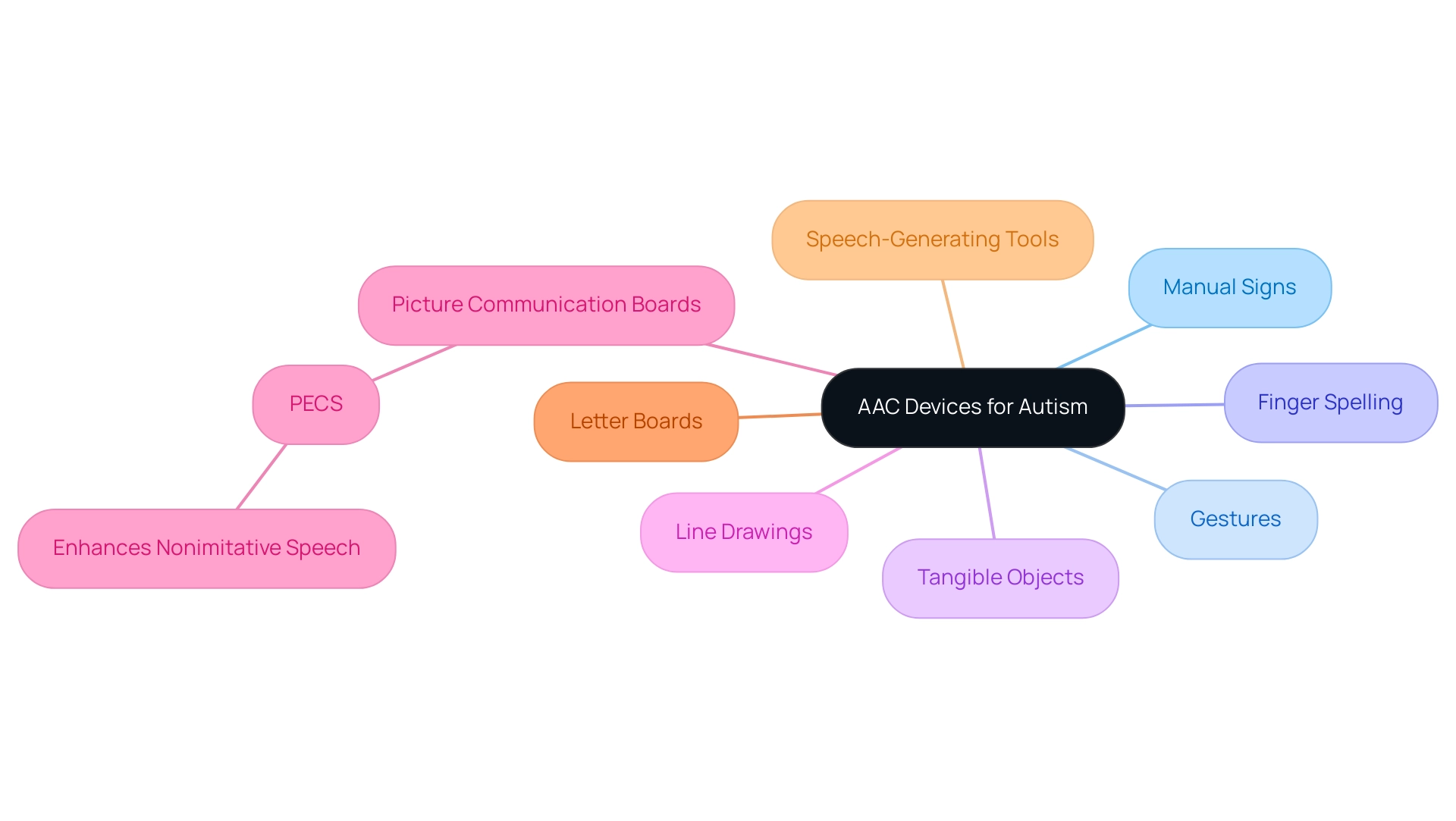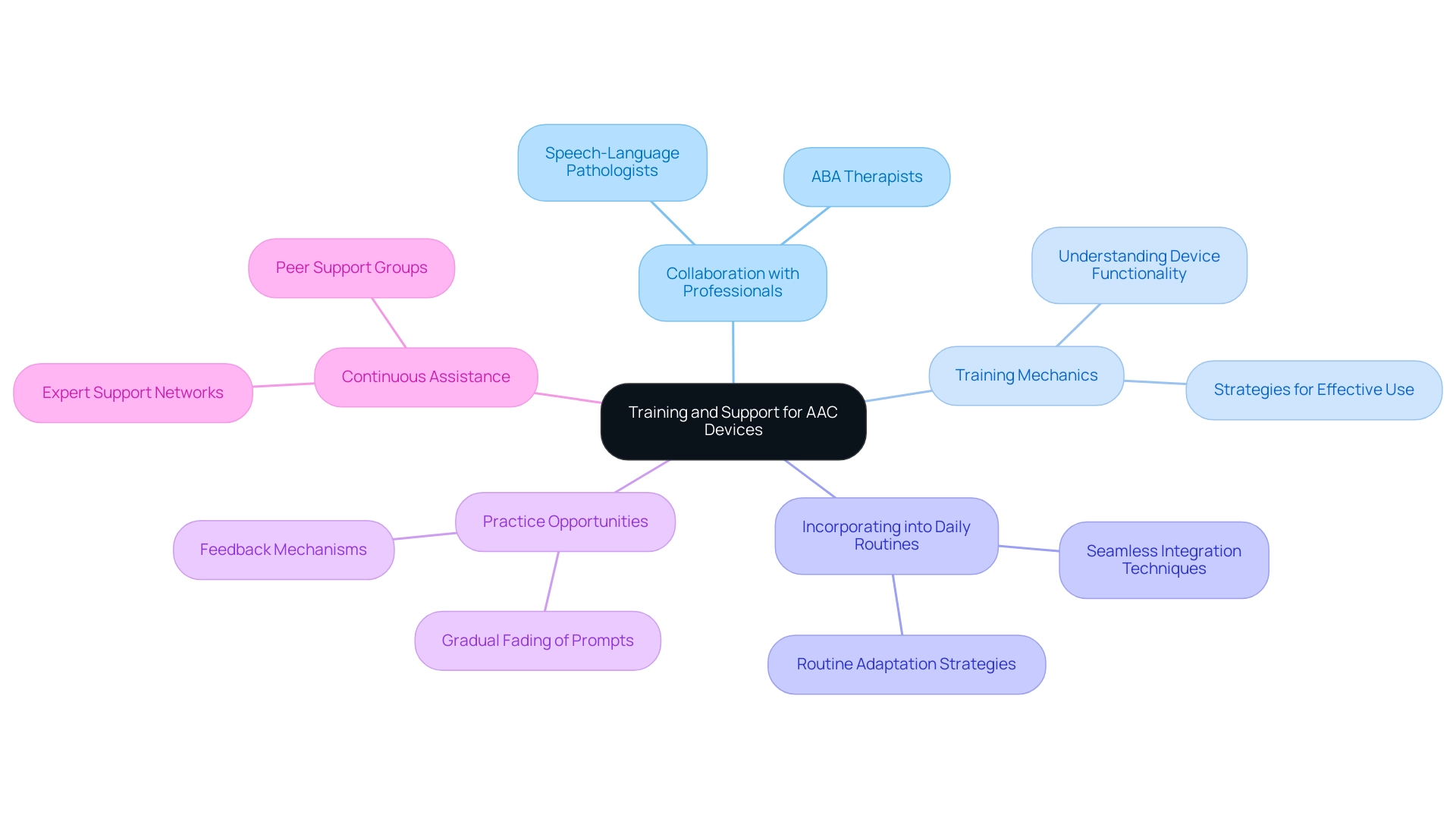Introduction
Navigating the world of communication can be a daunting challenge for children with autism, especially when verbal expression is hindered. Augmentative and Alternative Communication (AAC) devices emerge as transformative tools that not only facilitate communication but also empower children to express their needs, thoughts, and emotions.
From simple picture boards to sophisticated speech-generating technologies, AAC devices cater to a diverse range of communication styles and preferences. Understanding the various types of AAC options available is crucial for parents who are committed to advocating for their children’s expressive capabilities.
This article delves into the essential aspects of AAC, exploring its benefits, types, and key considerations for selecting the right device, while emphasizing the importance of tailored support and training to maximize its effectiveness in enhancing communication skills.
Understanding Augmentative and Alternative Communication (AAC) Devices
Augmentative and Alternative Interaction (AAC) tools are essential communication devices for autism, serving as vital resources for individuals who face challenges with spoken expression, particularly young people. These communication devices for autism can vary widely, ranging from basic picture boards to advanced speech-generating technologies, each designed to support unique expression needs. Understanding the spectrum of communication devices for autism is vital for parents advocating for their offspring’s expressive capabilities.
Research suggests that communication devices for autism, including AAC, can greatly improve a young person's ability to express their needs, thoughts, and feelings, thus playing a crucial role in closing gaps in interaction between youngsters and their caregivers. For instance, statistics show that 12% of adult AAC users self-report using keyguard as their access method, highlighting a specific approach within AAC utilization. This improved ability fosters deeper interactions and understanding, empowering families to connect more meaningfully.
As highlighted by an educator, 'the tools would just turn up … (we all agree) that is not an appropriate choice for that person (in school),' emphasizing that the effectiveness of these tools is rooted in their appropriateness for the individual user. This underscores the necessity of tailored solutions for success. Additionally, the case study titled 'Cultural Considerations in AAC' illustrates how cultural beliefs can influence AAC service delivery, ensuring that interventions are tailored to the unique communicative needs and cultural contexts of users.
By utilizing communication devices for autism, parents can support their child's autonomy and improve their daily experiences, ultimately boosting interaction abilities and overall quality of life.
Exploring Different Types of AAC Devices for Autism
AAC tools are generally classified into two primary categories: unaided and aided interaction systems. Unaided systems depend solely on the user's body, encompassing methods like sign language and gestures, which can be highly effective for many individuals. On the other hand, supported systems make use of external tools, such as communication devices for autism, speech-generating instruments, and mobile applications, to enhance dialogue.
Among the most popular supported communication devices for autism are Proloquo2Go, TouchChat, and GoTalk, each created with unique features that address diverse interaction needs. For instance, Proloquo2Go offers customizable vocabulary and a user-friendly interface, while TouchChat provides robust options for creating personalized interaction setups. It's essential for parents to thoughtfully assess their offspring's preferences and abilities when contemplating communication devices for autism, as the appropriate device can greatly improve their interaction skills.
Recent statistics reveal that 46% of patients in Germany demonstrated a need for AAC, specifically communication devices for autism, yet a significant 39% were unable to access these vital tools, underscoring the urgency of advocacy and awareness in ensuring all children receive the support they need. Additionally, language representation methods in AAC, including alphabet-based techniques, single-meaning messages, and semantic compaction, serve different interaction needs, and users may employ a combination of these methods with communication devices for autism based on their preferences and the functionality of their AAC systems. Moreover, firms in the AAC sector are creating touch-based speech-generating tools, like the TD I-110 introduced by Tobii Dynavox, which are considered advanced communication devices for autism to improve interaction.
As noted by speech-language pathologist O. Harris,
SLPs also recognize that not all individuals who use AAC will share the same beliefs about AAC as their families.
This insight reinforces the need for parents to actively engage in discussions about AAC choices with their offspring, fostering an environment of understanding and support.
The Benefits of AAC Devices in Enhancing Communication Skills
Communication devices for autism serve as an essential resource in improving interaction skills among children with autism, providing them a significant means to articulate themselves and reduce the frustration that can arise from interaction challenges. These items encompass a variety of techniques and tools, including:
- Manual signs
- Gestures
- Finger spelling
- Tangible objects
- Line drawings
- Picture communication boards
- Letter boards
- Speech-generating tools
Research highlights the transformative influence of these tools, demonstrating that they not only aid in enhanced language development but also encourage greater social interactions and nurture increased independence.
For instance, studies indicate that the Picture Exchange Communication System (PECS) significantly enhances nonimitative speech compared to non-AAC conditions, as noted by Schlosser and Wendt. The empowerment that arises from being able to communicate needs and emotions cannot be overstated; communication devices for autism enable children to engage more meaningfully with their peers and caregivers, paving the way for richer interactions. As emphasized by Rogers SJ in their pilot study, effective interventions such as the Denver Model and PROMPT can further enhance the benefits of AAC, illustrating the importance of customized approaches in supporting language development in various interaction contexts.
Moreover, a thorough evaluation recognizes impairments in body structure and function, comorbid deficits, limitations in activity and participation, and contextual factors influencing interaction, highlighting the essential role that communication devices for autism play in addressing these challenges.

Key Considerations for Choosing the Right AAC Device
Selecting the appropriate communication devices for autism for a young individual entails several crucial factors that can greatly impact their interaction journey. First and foremost, take into account the young person's age, as this can impact their developmental stage and communication goals. Moreover, recognizing the young person's unique interests is essential, as these interests can improve their involvement and ease with the tool.
Evaluate the gadget's ease of use and portability, ensuring it can seamlessly integrate into daily life. Compatibility with other tools and apps is another vital factor, as it can enhance functionality and user experience.
Involving a team of professionals, including speech-language pathologists (SLPs) and ABA practitioners, can provide invaluable insights tailored to the individual's unique needs. These specialists can assist in documenting the medical necessity for AAC accessories and guide the selection process to ensure the item is the most suitable choice. As emphasized by Beukelman et al., merging core and fringe vocabulary can greatly enhance the frequency of AAC use, making it vital to consider language representation methods that correspond with the individual's style of expression.
For instance, case studies on language representation methods (LRMs) demonstrate how different approaches, such as semantic compaction and alphabet-based methods, serve various communication needs, showcasing the importance of personalized AAC solutions.
Research has shown (PMID: 31791963) that communication devices for autism can profoundly impact a young person's ability to communicate effectively. Furthermore, upcoming studies should concentrate on improving user experience and broadening the uses of advanced AAC systems, particularly communication devices for autism, guaranteeing that technological progress persists in addressing the changing requirements of youngsters with autism.
Essentially, the optimal AAC tool should enable the individual, nurturing their capacity to communicate effectively and confidently in diverse environments.
Training and Support: Ensuring Effective Use of AAC Devices
Effective utilization of communication devices for autism hinges on comprehensive training and robust support systems for parents. It is crucial for parents to collaborate with professionals who specialize in AAC implementation, such as speech-language pathologists and ABA therapists. Training should include not only the mechanics of using communication devices for autism but also strategies for seamlessly incorporating them into daily routines, improving the child's interaction efforts.
A study presented at the 2016 IEEE International Conference on RTEICT emphasizes the effectiveness of breath to speech interactions, highlighting the potential of communication devices for autism in enhancing expression results. As noted by Atkinson, Derry, Renkl, and Wortham, this training component should provide parents with ample opportunities for practice, incorporating gradual fading of instructor prompting and feedback, which is vital for effective learning. Furthermore, insights from the case study titled 'General Procedures for Strategy Instruction' demonstrate how structured strategy instruction can reinforce learning and application of communication devices for autism among parents.
Continuous assistance from experts and peer networks is priceless, providing parents with the confidence and resources needed to tackle challenges and celebrate milestones in their communication journey. By prioritizing these support systems, parents can significantly enhance their effectiveness in fostering their child's communicative abilities.

Conclusion
AAC devices are pivotal in transforming the communication landscape for children with autism, offering diverse options that cater to their unique needs. From basic picture boards to advanced speech-generating technologies, these tools not only facilitate expression but also empower children to engage meaningfully with their surroundings. The evidence supporting the effectiveness of AAC is compelling; it enhances language development, promotes social interactions, and fosters independence, allowing children to convey their thoughts and emotions with greater ease.
Selecting the right AAC device requires careful consideration of various factors, including the child's age, preferences, and the device's functionality. Involving professionals in the decision-making process ensures that the chosen device aligns with the child's specific communication goals. Moreover, comprehensive training and ongoing support for parents are essential to maximize the potential of AAC devices. This collaborative approach not only enhances the child's communication skills but also strengthens the bond between children and their caregivers.
Ultimately, advocating for the use of AAC devices can significantly improve the quality of life for children with autism. By understanding the available options and committing to tailored support, parents can empower their children to overcome communication barriers, fostering a more inclusive and connected environment. The journey towards effective communication is a shared one, and with the right tools and resources, every child can find their voice.
Frequently Asked Questions
What are Augmentative and Alternative Communication (AAC) tools?
AAC tools are communication devices designed to assist individuals, particularly those with autism, who face challenges with spoken expression. They range from basic picture boards to advanced speech-generating technologies, tailored to support unique expression needs.
How do AAC tools benefit individuals with autism?
AAC tools improve a young person's ability to express their needs, thoughts, and feelings, thereby enhancing interactions with caregivers and fostering deeper connections within families.
What types of AAC systems exist?
AAC systems are classified into two primary categories: unaided systems, which rely solely on the user's body (like sign language and gestures), and aided systems that utilize external tools such as communication devices, speech-generating instruments, and mobile applications.
What are some examples of popular supported communication devices for autism?
Popular supported communication devices include Proloquo2Go, TouchChat, and GoTalk, each designed with unique features to address diverse interaction needs.
Why is it important to tailor AAC tools to individual users?
The effectiveness of AAC tools is rooted in their appropriateness for the individual user. Tailored solutions enhance the chances of success in improving communication abilities.
What statistics highlight the need for AAC tools?
Research indicates that 46% of patients in Germany demonstrated a need for AAC, yet 39% were unable to access these tools, emphasizing the need for advocacy and awareness.
How can parents support their child's use of AAC tools?
Parents can support their child's autonomy and improve daily experiences by thoughtfully assessing their preferences and abilities when selecting communication devices, and engaging in discussions about AAC choices.
What are some language representation methods used in AAC?
Language representation methods in AAC include alphabet-based techniques, single-meaning messages, and semantic compaction, which cater to different interaction needs.
What advancements are being made in AAC technology?
Companies in the AAC sector are developing advanced communication devices, such as touch-based speech-generating tools like the TD I-110 by Tobii Dynavox, to enhance interaction capabilities.




